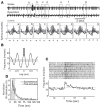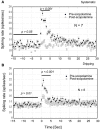The basal forebrain modulates spontaneous activity of principal cells in the main olfactory bulb of anesthetized mice
- PMID: 24065892
- PMCID: PMC3778317
- DOI: 10.3389/fncir.2013.00148
The basal forebrain modulates spontaneous activity of principal cells in the main olfactory bulb of anesthetized mice
Abstract
Spontaneous activity is an important characteristic of the principal cells in the main olfactory bulb (MOB) for encoding odor information, which is modulated by the basal forebrain. Cholinergic activation has been reported to inhibit all major neuron types in the MOB. In this study, the effect of diagonal band (NDB) stimulation on mitral/tufted (M/T) cell spontaneous activity was examined in anesthetized mice. NDB stimulation increased spontaneous activity in 66 MOB neurons which lasted for 2-35 s before returning to the baseline level. The majority of the effected units showed a decrease of interspike intervals (ISI) at a range of 8-25 ms. Fifty-two percent of NDB stimulation responsive units showed intrinsic rhythmical bursting, which was enhanced temporarily by NDB stimulation, whereas the remaining non-rhythmic units were capable of synchronized bursting. The effect was attenuated by scopolamine in 21 of 27 units tested. Only four NDB units were inhibited by NDB stimulation, an inhibition that lasted less than 10 s. The NDB stimulation responsive neurons appeared to be M/T cells. Our findings demonstrate an NDB excitation effect on M/T neurons that mostly requires muscarinic receptor activation, and is likely due to non-selectivity of electrical stimulation. This suggests that cholinergic and a diverse group of non-cholinergic neurons in the basal forebrain co-ordinately modulate the dynamics of M/T cell spontaneous activity, which is fundamental for odor representation and attentional perception.
Keywords: diagonal band; mitral cell; olfactory bulb; scopolamine; synchronization; tufted cell.
Figures










Similar articles
-
Evidence for presynaptic inhibition of the olfactory commissural pathway by cholinergic agonists and stimulation of the nucleus of the diagonal band.J Neurosci. 1993 Feb;13(2):650-9. doi: 10.1523/JNEUROSCI.13-02-00650.1993. J Neurosci. 1993. PMID: 8426231 Free PMC article.
-
Optogenetic activation of basal forebrain cholinergic neurons modulates neuronal excitability and sensory responses in the main olfactory bulb.J Neurosci. 2012 Jul 25;32(30):10105-16. doi: 10.1523/JNEUROSCI.0058-12.2012. J Neurosci. 2012. PMID: 22836246 Free PMC article.
-
Steady-state centrifugal input via the lateral olfactory tract modulates spontaneous activity in the rat main olfactory bulb.Neuroscience. 2017 Apr 21;348:165-179. doi: 10.1016/j.neuroscience.2017.02.013. Epub 2017 Feb 16. Neuroscience. 2017. PMID: 28215749
-
Subpopulations of Projection Neurons in the Olfactory Bulb.Front Neural Circuits. 2020 Aug 28;14:561822. doi: 10.3389/fncir.2020.561822. eCollection 2020. Front Neural Circuits. 2020. PMID: 32982699 Free PMC article. Review.
-
Newborn neurons in the adult olfactory bulb: unique properties for specific odor behavior.Behav Brain Res. 2012 Feb 14;227(2):480-9. doi: 10.1016/j.bbr.2011.08.001. Epub 2011 Aug 6. Behav Brain Res. 2012. PMID: 21843557 Review.
Cited by
-
Dynamic Cholinergic Tone in the Basal Forebrain Reflects Reward-Seeking and Reinforcement During Olfactory Behavior.Front Cell Neurosci. 2021 Feb 2;15:635837. doi: 10.3389/fncel.2021.635837. eCollection 2021. Front Cell Neurosci. 2021. PMID: 33603646 Free PMC article.
-
Short-Term Plasticity in Cortical GABAergic Synapses on Olfactory Bulb Granule Cells Is Modulated by Endocannabinoids.Front Cell Neurosci. 2021 Feb 9;15:629052. doi: 10.3389/fncel.2021.629052. eCollection 2021. Front Cell Neurosci. 2021. PMID: 33633545 Free PMC article.
-
Co-transmitting neurons in the lateral septal nucleus exhibit features of neurotransmitter switching.IBRO Neurosci Rep. 2022 May 12;12:390-398. doi: 10.1016/j.ibneur.2022.05.003. eCollection 2022 Jun. IBRO Neurosci Rep. 2022. PMID: 35601692 Free PMC article.
-
The Interglomerular Circuit Potently Inhibits Olfactory Bulb Output Neurons by Both Direct and Indirect Pathways.J Neurosci. 2016 Sep 14;36(37):9604-17. doi: 10.1523/JNEUROSCI.1763-16.2016. J Neurosci. 2016. PMID: 27629712 Free PMC article.
-
Rapid Effects of Vagus Nerve Stimulation on Sensory Processing Through Activation of Neuromodulatory Systems.Front Neurosci. 2022 Jul 5;16:922424. doi: 10.3389/fnins.2022.922424. eCollection 2022. Front Neurosci. 2022. PMID: 35864985 Free PMC article. Review.
References
-
- Buonviso N., Chaput M. A., Berthommier F. (1992). Temporal pattern analyses in pairs of neighboring mitral cells. J. Neurophysiol. 68, 417–424 - PubMed
Publication types
MeSH terms
Substances
Grants and funding
LinkOut - more resources
Full Text Sources
Other Literature Sources

